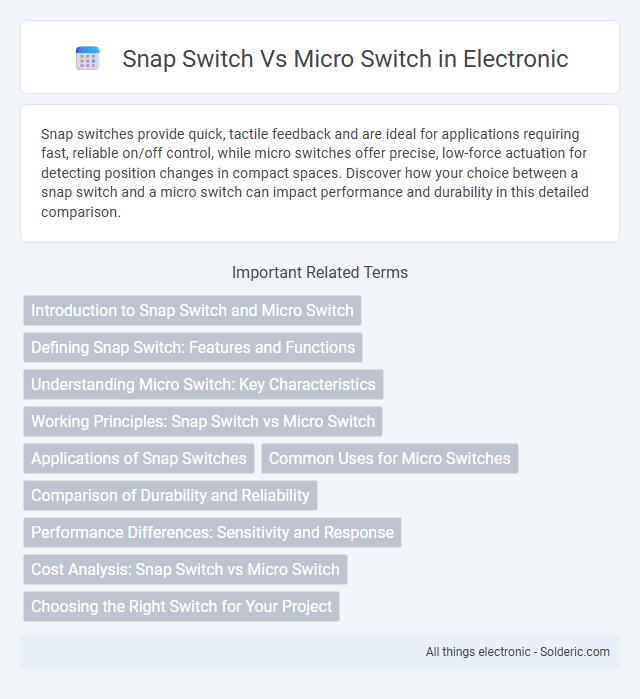Snap switches provide quick, tactile feedback and are ideal for applications requiring fast, reliable on/off control, while micro switches offer precise, low-force actuation for detecting position changes in compact spaces. Discover how your choice between a snap switch and a micro switch can impact performance and durability in this detailed comparison.
Comparison Table
| Feature | Snap Switch | Micro Switch |
|---|---|---|
| Function | Rapid mechanical switching action | Precision switching with small movements |
| Operating Mechanism | Snap-action, quick contact change | Lever or plunger actuated with snap action |
| Applications | Light switches, industrial controls | Limit switches, safety devices, appliances |
| Size | Generally larger, bulkier | Compact, small footprint |
| Sensitivity | Moderate actuation force required | Low actuation force, high sensitivity |
| Durability | High mechanical life | Extremely high cycle life |
| Typical Voltage & Current Rating | Up to 250V, 10A | Up to 125V, 15A |
Introduction to Snap Switch and Micro Switch
Snap switches and micro switches are essential components in electronic devices, known for their precise switching capabilities. Snap switches operate with a quick, audible snap action triggered by a mechanical force, ensuring rapid contact change. Micro switches, a type of snap switch, provide high reliability and durability in applications requiring frequent actuation, making them ideal for your sensitive control systems.
Defining Snap Switch: Features and Functions
Snap switches are electromechanical devices characterized by a rapid, tactile action generated by a spring mechanism that "snaps" the contacts open or closed. These switches ensure reliable, consistent operation with a defined switching point, often used in applications requiring precise control and durability. Your choice of a snap switch offers distinct advantages in terms of responsiveness and longevity compared to slower or less tactile alternatives.
Understanding Micro Switch: Key Characteristics
A micro switch features a small, compact design with a highly sensitive actuator, enabling precise and reliable switching in tight spaces. Its snap-action mechanism ensures quick, consistent contact transition with minimal required force, ideal for applications demanding durability and longevity. Understanding these key characteristics helps you choose the right switch for accurate control in electronics and automation systems.
Working Principles: Snap Switch vs Micro Switch
Snap switches operate using a spring-loaded mechanism that rapidly moves the contact points between open and closed positions, ensuring quick and reliable switching actions. Micro switches function through a small, precise internal lever or button that triggers the internal spring to activate or deactivate the electrical circuit with minimal force. Your choice between the two depends on the required sensitivity and mechanical durability for your application.
Applications of Snap Switches
Snap switches are widely used in household appliances, automotive controls, and industrial machinery due to their fast response and reliable actuation under mechanical stress. Their design enables precise on/off actions in lighting systems, HVAC units, and safety mechanisms where consistent electrical contact is crucial. Snap switches excel in applications requiring compact size, durability, and high cycling performance, making them ideal for repetitive mechanical operations.
Common Uses for Micro Switches
Micro switches are widely used in appliances, industrial machinery, and automotive systems due to their reliability and precise switching action. Their ability to operate with minimal physical force and high durability makes them ideal for limit switches, safety controls, and vending machines. If you need accurate and consistent performance in small, space-constrained applications, micro switches provide an efficient solution.
Comparison of Durability and Reliability
Snap switches offer high durability with quick mechanical action, making them suitable for frequent on-off cycles and providing reliable performance in low to moderate load applications. Micro switches excel in reliability due to their precise internal mechanism and robust construction, delivering consistent performance under high load and harsh environmental conditions. Both switches are designed for longevity, but micro switches typically withstand higher operational stress and provide better resistance to wear and tear.
Performance Differences: Sensitivity and Response
Snap switches exhibit high sensitivity with a rapid response time due to their bistable mechanism, making them ideal for applications requiring quick, reliable actuation. Micro switches, while also sensitive, offer more precise control with consistent repeatability and can withstand higher electrical loads under frequent switching conditions. The performance difference lies in snap switches providing faster actuation with a simple on/off function, whereas micro switches deliver enhanced durability and accuracy in response sensitivity.
Cost Analysis: Snap Switch vs Micro Switch
Snap switches typically offer a more cost-effective solution compared to micro switches due to simpler design and materials, making them ideal for budget-sensitive applications. Micro switches provide higher precision and durability, often resulting in a higher initial investment but reduced long-term maintenance costs. Your choice should balance upfront cost with performance requirements, especially in environments demanding frequent or high-accuracy switching.
Choosing the Right Switch for Your Project
Snap switches offer rapid, tactile feedback with a simple design ideal for applications requiring quick on/off actions, while micro switches provide precise, reliable operation in compact spaces with higher durability. You should evaluate factors such as contact rating, actuation force, size constraints, and environmental conditions to determine which switch best suits your project's performance and reliability needs. Selecting the right switch enhances functionality and ensures optimal longevity in your electronic or mechanical systems.
snap switch vs micro switch Infographic

 solderic.com
solderic.com